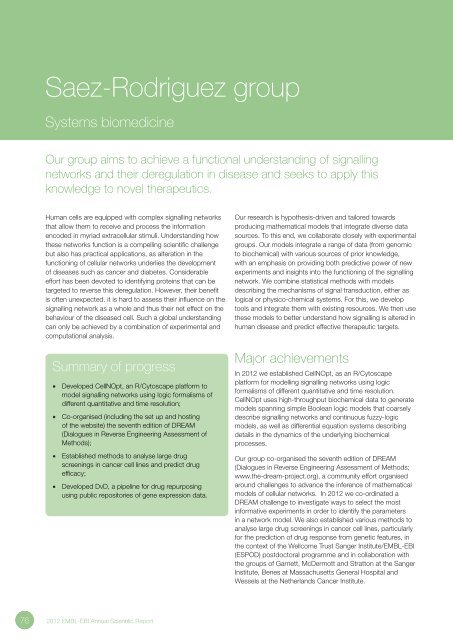EMBL-EBI Annual Scientific Report 2012
EMBL-EBI Annual Scientific Report 2012
EMBL-EBI Annual Scientific Report 2012
- No tags were found...
Create successful ePaper yourself
Turn your PDF publications into a flip-book with our unique Google optimized e-Paper software.
Saez-Rodriguez groupSystems biomedicineOur group aims to achieve a functional understanding of signallingnetworks and their deregulation in disease and seeks to apply thisknowledge to novel therapeutics.Human cells are equipped with complex signalling networksthat allow them to receive and process the informationencoded in myriad extracellular stimuli. Understanding howthese networks function is a compelling scientific challengebut also has practical applications, as alteration in thefunctioning of cellular networks underlies the developmentof diseases such as cancer and diabetes. Considerableeffort has been devoted to identifying proteins that can betargeted to reverse this deregulation. However, their benefitis often unexpected. it is hard to assess their influence on thesignalling network as a whole and thus their net effect on thebehaviour of the diseased cell. Such a global understandingcan only be achieved by a combination of experimental andcomputational analysis.Summary of progress• Developed CellNOpt, an R/Cytoscape platform tomodel signalling networks using logic formalisms ofdifferent quantitative and time resolution;• Co-organised (including the set up and hostingof the website) the seventh edition of DREAM(Dialogues in Reverse Engineering Assessment ofMethods);• Established methods to analyse large drugscreenings in cancer cell lines and predict drugefficacy;• Developed DvD, a pipeline for drug repurposingusing public repositories of gene expression data.Our research is hypothesis-driven and tailored towardsproducing mathematical models that integrate diverse datasources. To this end, we collaborate closely with experimentalgroups. Our models integrate a range of data (from genomicto biochemical) with various sources of prior knowledge,with an emphasis on providing both predictive power of newexperiments and insights into the functioning of the signallingnetwork. We combine statistical methods with modelsdescribing the mechanisms of signal transduction, either aslogical or physico-chemical systems. For this, we developtools and integrate them with existing resources. We then usethese models to better understand how signalling is altered inhuman disease and predict effective therapeutic targets.Major achievementsIn <strong>2012</strong> we established CellNOpt, as an R/Cytoscapeplatform for modelling signalling networks using logicformalisms of different quantitative and time resolution.CellNOpt uses high-throughput biochemical data to generatemodels spanning simple Boolean logic models that coarselydescribe signalling networks and continuous fuzzy-logicmodels, as well as differential equation systems describingdetails in the dynamics of the underlying biochemicalprocesses.Our group co-organised the seventh edition of DREAM(Dialogues in Reverse Engineering Assessment of Methods;www.the-dream-project.org), a community effort organisedaround challenges to advance the inference of mathematicalmodels of cellular networks. In <strong>2012</strong> we co-ordinated aDREAM challenge to investigate ways to select the mostinformative experiments in order to identify the parametersin a network model. We also established various methods toanalyse large drug screenings in cancer cell lines, particularlyfor the prediction of drug response from genetic features, inthe context of the Wellcome Trust Sanger Institute/<strong>EMBL</strong>-<strong>EBI</strong>(ESPOD) postdoctoral programme and in collaboration withthe groups of Garnett, McDermott and Stratton at the SangerInstitute, Benes at Massachusetts General Hospital andWessels at the Netherlands Cancer Institute.76 <strong>2012</strong> <strong>EMBL</strong>-<strong>EBI</strong> <strong>Annual</strong> <strong>Scientific</strong> <strong>Report</strong>
















